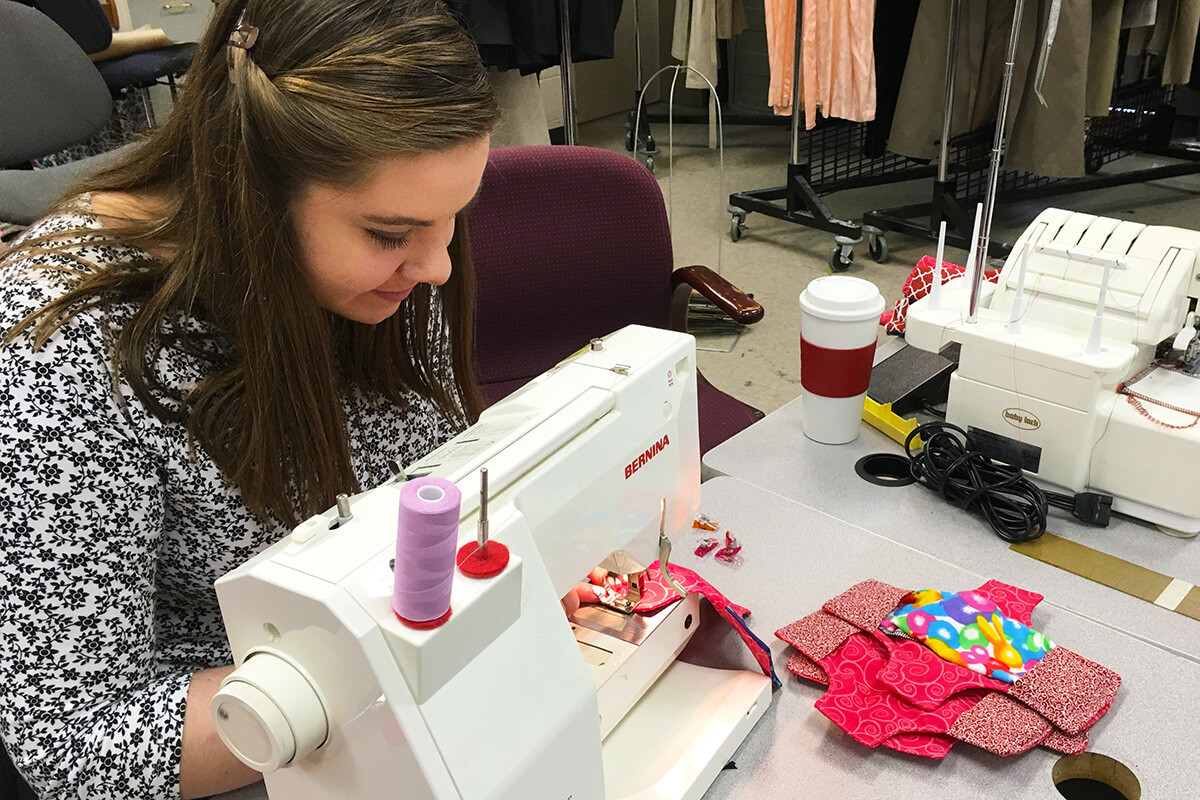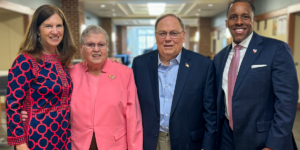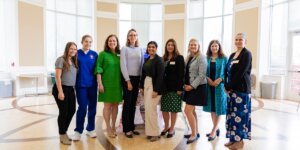In mid-December 2015, students in the stage costuming class led by Costume Designer and Associate Professor of Costume Design Cheryl Yancey, M.F.A., ripped fabric, manned sergers and wrangled with a material called PUL (a lightweight polyester lining ideal for blocking moisture). They measured and occasionally looked hesitant as they embarked on a group service-learning project to make parts of feminine hygiene kits to be distributed through Days for Girls International, allowing girls around the world to attend school, rather than hide or be shunned, during their menstrual cycles.
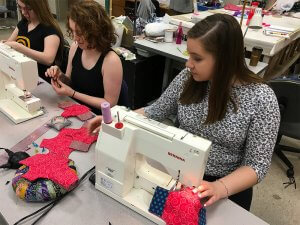
Pictured from left to right are costume design majors Madeleine Tlapek-La Vean ’17, Lauren Mitchell ’18, and Mallory Veil ’19, sewing items for Days for Girls International kits.
“It will all make sense when you start putting it together, I promise,” Yancey reassured her students in a calm, experienced tone. Yancey, who has taught at Shenandoah for 21 years, demonstrated how to tear fabric as she good-naturedly explained her prowess to her students. “I’ve been doing this probably longer than you and your mom has been alive.”
At Shenandoah, the union of academic work and service, or service-learning, is part of the university experience. It’s even part of its 2025 Strategic Plan, in the area of transformative learning, where one of the goals is to “engage students in learning and service activities in partnership with communities and organizations external to the university,” noted Center for Public Service and Scholarship Director and Professor Karen Kennedy Schultz, Ph.D. Service-learning is so important to the university that it has brought an expert in the subject, Drew Stelljes, Ph.D., assistant vice president at the College of William & Mary, to Shenandoah several times, most recently in August 2015, when he presented a workshop in which about 35 faculty members participated, Schultz noted.
The value of service-learning “derives directly from the relationships that are built when students are in community working directly with individuals who may be from quite a different demographic,” Schultz added. “The students reflect on their service as to why the need for service exists, how it impacts the community, what are the difficulties and how can any of those difficulties be overcome. Contacts are made outside of the university environment. Ideas and concepts explored in a classroom can be applied and considered in a ‘real-life’ context.”
“It was really interesting doing all the research,” about Days for Girls, said dance major Dani Maloney ’18, who said the information made her realize she took for granted her access to certain products, and opened her eyes to how girls are living in circumstances she never would have imagined – staying out of school or being exiled from their families – just because of their biology. By working on a kit, she said she feels as if she “gave a female around the world a life.”
“Not only a life, but a future,” added her classmate, costume design major Maggie Neal ’19.
The Days for Girls effort was the second group service-learning project undertaken by Yancey’s class. The first – in which the class made cooler bags for people carrying food from Winchester’s Congregational Community Action Project (C-CAP) which serves people in need – inspired her to incorporate a service-learning component in future stage costuming classes because of the deeper meaning of such projects. They offer a revelation to the crafters, she said. One in which they learn, “I can use my art to help others.”
Service-learning takes a wide variety of forms at Shenandoah, as some faculty members and students revealed in an October 2015 panel discussion held on the topic at Brandt Student Center.
Professor of Environmental Studies and Biology Woodward Bousquet, Ph.D., said service-learning is an integral part of preparing environmental studies students for future careers, adding that the major includes two classes incorporating service-learning components, and a capstone course that includes a month-long service learning project.
Bousquet noted how a 1998 Environmental Sampling and Analysis class conducted research on a Winchester property at the urging of a city official, discovering information about the water quality of Abrams Creek in Winchester and the rare plants near it. “All of the students took incompletes in the research class because they were so excited about what they had discovered in the Abrams Creek wetlands that they said: ‘We need to put out a report that’s understandable by people who aren’t scientists.’ So they took the extra semester to write this report” – which Bousquet held in in his hand as he spoke – “which made a heck of a great job credential, by the way. . . and when you speak about impacts [of service-learning], this property became, in 2003, Winchester’s first formally dedicated and protected natural area.” Since then, other environmental studies classes have produced a guide for residents about being a good neighbor to the wetlands, as well as a brochure about natural areas of interest in the region, which is in its fourth printing, meaning about 15,000 copies are in circulation, Bousquet said.
Kaitlinn Lose, a student who took the Adult Years and the Aging Process course taught by Associate Professor of Psychology Scott King, Ph.D., said the service-learning component of that course, which included visits to the Shenandoah Area Agency on Aging’s Adult Living Center in Jim Barnett Park, adjacent to the university’s main campus in Winchester, upended her preconceived notions about older people, which is one of King’s goals for the class – to combat ageism and dismantle stereotypes associated with all age groups.
Lose said she expected to encounter infirm, delicate center participants, but instead she saw people moving around and talking about the “Senior Olympics” in which SAAA center participants compete each year. “They were sassy, had so much spunk to them, and they really kept me on my toes,” she said. “It was an absolutely amazing experience. It opened my mind so much.” The class was so meaningful, “I would take it again in a heartbeat if I could,” she said.
King has also learned something about himself in the past few years via service-learning: that he should leave fundraising for the Active Living Center to his students. About four years ago, he spearheaded the class effort to raise money to help support the center and its parent organization. The first year went well. The second, not so much. Then, he realized that when he stepped back and let students take the reins, their ideas led to greater fundraising success.
For senior environmental studies major Sydney Vonada, the service-learning opportunities she had in her Environmental Education class – in which students class taught a local kindergarten class about the environment and educated adults about Shenandoah’s River Campus at Cool Spring Battlefield in Clarke County – inspired her ambition to be a non-traditional environmental educator.
Successes appear to abound where service-learning is involved. “Our new faculty member, Assistant Professor of Management Bret Sanner, Ph.D., involved his 56 BUS 307 undergraduate students class in 12 community projects. The robust assessment by the students and the community project coordinator indicated tremendous success and learning both by the partner agency and by the students,” Schultz said. Service-learning can also have another angle – that of advocacy. Emily Ellis, a junior music education major, said that’s how the concept works within her program, where selfless advocacy efforts allow students to act as change agents in their field while undertaking their studies, and later, when they’re educators.
“It’s empowering to know that you make a difference,” said Leah Harrell, a junior acting major who worked on the cooler bag project in Yancey’s costume design class.
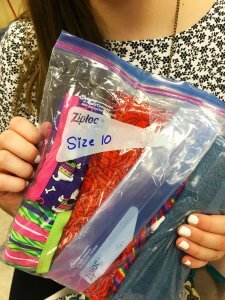 Costume design major Mallory Veil ’19, who brought the Days for Girls project idea to Yancey’s class this year, said it was wonderful to get a chance to spread the word about the Days for Girls organization and its mission. Yancey, who personally purchased some fabric for the project, said she would tell people in the fabric store about it, for example. Acting major Darcy Pierce ’18 said she hoped her mother would share the idea with people at the sewing studio she uses, too.
Costume design major Mallory Veil ’19, who brought the Days for Girls project idea to Yancey’s class this year, said it was wonderful to get a chance to spread the word about the Days for Girls organization and its mission. Yancey, who personally purchased some fabric for the project, said she would tell people in the fabric store about it, for example. Acting major Darcy Pierce ’18 said she hoped her mother would share the idea with people at the sewing studio she uses, too.
Acting major Tony Matteson ’18, added by helping make the kits, he helped prevent girls from being taken advantage of just because they don’t have the products they need (an idea unimaginable for Matteson who grew up with two sisters). “It’s a good feeling to be able to help people around the world,” he said.
Around the world or close to home, service-learning, as practiced by Shenandoah, does make a difference.
